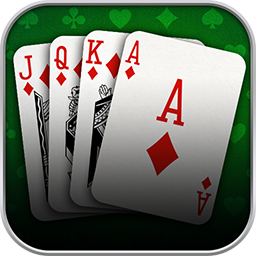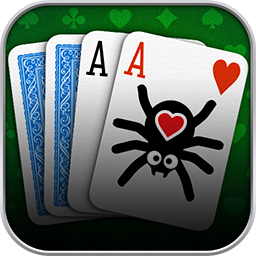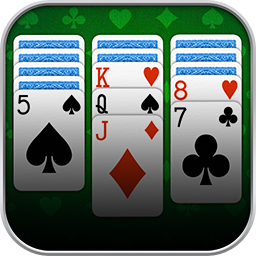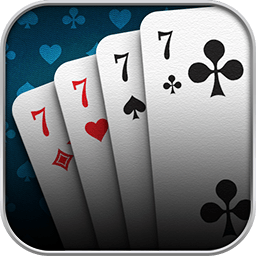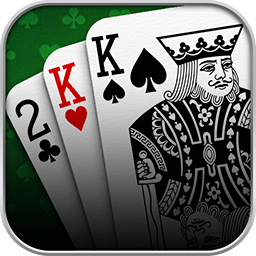At the Rummy Palace, you get to play German Rummy anytime against fellow card game enthusiasts from all over the world! We offer basic Rummy rules perfectly adjusted for novices, as they are manageable and easily understood. Once you have gained some experience, you can employ custom rules and tailor the game to your wishes. On this page, we’ll cover how to play Rummy, including setting up the game, gameplay, the objective of the game, and scoring.
How to Play Rummy in a Nutshell
The aim of Rummy is to get rid of your hand cards before your opponents do. To do so, you can play your cards as melds and add your cards to existing melds. According to the rules of Rummy, these melds must meet certain conditions, though. The round ends once a player discards their last card onto the discard pile. Then, it is time to count the points. And here goes the next round!
This thorough manual will guide you through all the Rummy rules and terms in detail. To quickly look up single terms, take a look at our glossary! And use our in-game help to answer any questions coming up on the fly at the Rummy Palace.
How Many People Can Play Rummy
Rummy is a card game for at least two players. Classic Rummy can be played with up to six players – at the Rummy Palace, you can play Rummy with two players up to four players.
Generally speaking, Rummy is better than Gin Rummy for playing with more than two players, as the rules can be easily adapted for more players, while the classic Gin Rummy rules are more suited to quickfire, head-to-head gameplay. Read more about the differences between Rummy and Gin Rummy.
In some variations of Rummy, when playing with more than two players, players are dealt fewer cards. But at the Rummy Palace, players are always dealt 13 cards each.
When playing with different numbers of players, the course and dynamic of the game can differ slightly. You can learn more in our lesson about how to approach a game of Rummy with different numbers of players.
Two Player Rummy
In two player Rummy, the default Rummy rules as we explain here apply. You and your opponent take turns to draw a card from either the discard pile or the stock pile and, during your turn, play melds to try and get rid of your hand cards the quickest. The round ends when one of you has melded all your hand cards and discarded your last card (or the stock pile runs out).
2 Player Rummy tends to be more intense and fast-paced, as your focus is just on one opponent. You can more easily keep track of which cards they’re picking up and discarding, and respond accordingly.
Three to Four Player Rummy
The basic rules of Rummy remain the same when playing 3 or 4 player Rummy. The main thing to note is that when you play Rummy with more than two Players, the player to go first is picked at random, then you play clockwise from there.
However, the nature of the game can differ quite significantly, due to the extra strategic complexities the third and fourth player bring. In 2 player Rummy, you only have to keep track of one player’s movements. But in 3 or 4 player Rummy, there are multiple opponents whose pickups and discards you need to try and remember, and react to. You will also have longer between turns, allowing more time to plan your next moves. This can lead to a more patient, strategic and sometimes cautious game.
The Rummy Playing Cards
How Many Cards Do You Need to Play Rummy
Rummy uses two decks of traditionally French-suited playing cards, including Jokers: 104 cards in the suits Spades, Clubs, Hearts, and Diamonds in 13 ranks – Two to Ten, Jack, Queen, King, and Ace plus six Jokers.
How Many Cards Are Dealt in Rummy
At the beginning of a round, each player is dealt 13 cards. These cards form each players’ hand. Then you try to get rid of all your hand cards by playing them as melds. As we said in the section about the number of players, at the Rummy Palace, players always receive 13 cards, regardless of how many players are in a game.
Rummy Cards – Ranks and Values
Each card has a rank and a corresponding value in Rummy. That value factors into two game elements: First, playing the initial meld (at least three cards with a minimum score of 30 points in total), and secondly, determining the players’ scores at the end of a round.
In Rummy, the numbered cards (Two to Ten) have a value equivalent to their number, while face cards – the Jack, Queen, and King – each have a value of ten points.

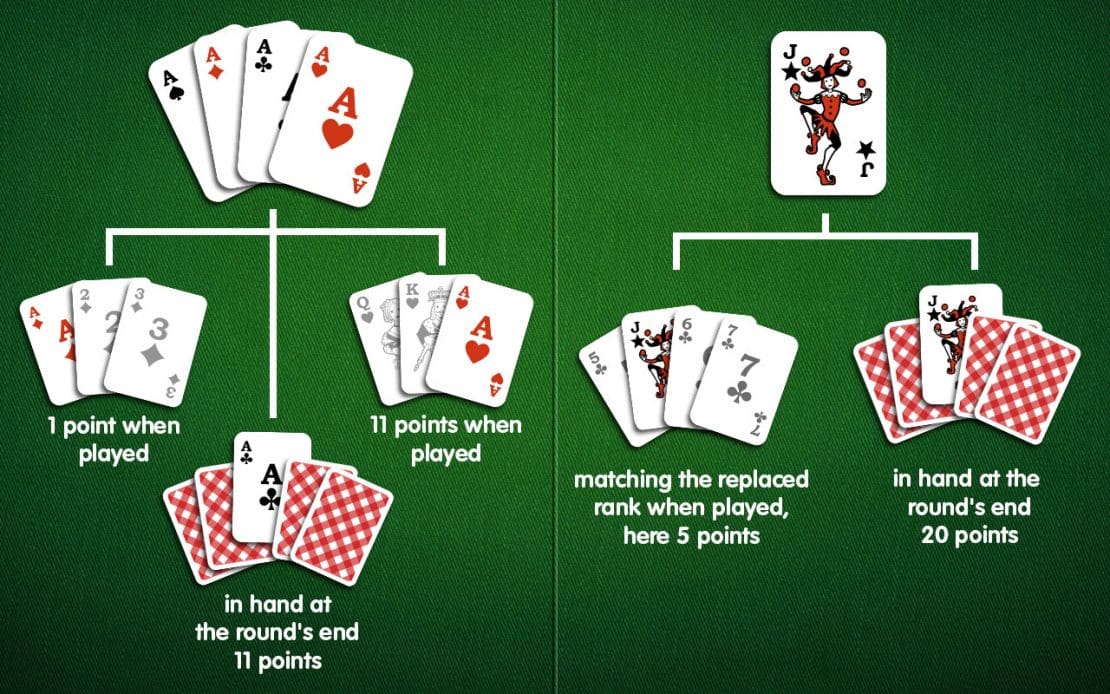
You should not risk having too many cards of higher value in your hand at the end of a round.
The Joker in Rummy
The Joker in Rummy can always be used to replace a card missing from a meld. Two consecutive Jokers in a meld are allowed, too, as long as there are not more Jokers than natural cards.
When any player – you or a fellow player – later receives the fitting card, they can swap their card with the Joker. Now they get to use the Joker for another meld.
This makes the Joker a very valuable card to have in Rummy. However, if you have a Joker in your hand at the end of the round, its value is 20 points. So you need to choose carefully when to play it, so that you’re not stuck with a joker in your hand when another player gets rid of all their cards.
The Ace in Rummy
The value of the Ace in Rummy can differ depending on the situation. When played in a meld, it can be used either:
- To begin a sequence followed by a Two and a Three. In this scenario, the Ace card has the value of one point
- Or to end a sequence preceded by a Queen and a King. In this scenario, the Ace card has the value of 11 points.
If you have an Ace in your hand at the end of the round, it is worth 11 points. So it can be wise to try and play your Ace sooner rather than later. Because if another player gets rid of all their cards first and ends the round, those 11 points will be deducted from your score, and added to theirs.
The Rummy Playing Field
Now that we know our material, let us take a look at the rules of Rummy and learn how to play Rummy! The playing field consists of two areas – the stock with the discard pile and the big melding area. Below the playing field, you see your hand cards and, during your turn, how much time you have left for your moves. If it is an opponent’s turn, the time they have left will be indicated close to their avatar. Finally, you always see how many cards your opponents are holding on the edges of the playing field.
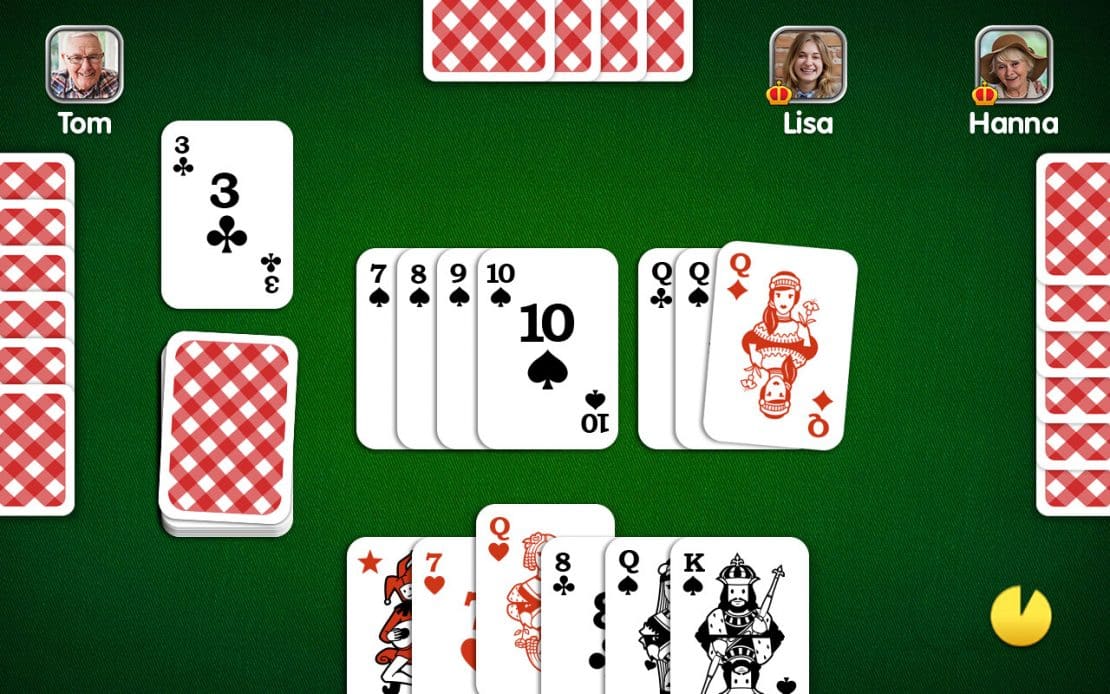
Melding Area
All players can put their melds in this area. As soon as a meld is played here, any player past their initial meld can add cards to it or swap Jokers.
Stock Pile
Once each player has received their initial 13 hand cards, the leftover cards become the face-down stock for drawing from. Its top card is revealed and placed next to it as the first card of the discard pile.
Discard Pile
The discard pile is formed by placing the top card of the stock pile face up in the playing field. During the course of the game, you and your opponents end your turn by placing one of your cards in the discard pile face up.
It’s important to keep an eye on what cards your opponents are putting down and picking up from the discard pile in Rummy. By keeping track of your opponents discards and pickups, you can try to work out what cards they might need, and play your discards and pickups accordingly to try and block them.
Course of the Game
According to the Rummy rules, you play in clockwise order with a randomly picked player starting the game. To begin your turn, you draw a card either from the stock or the discard pile, your choice. And you have to end each turn by putting a card on the discard pile. After that, the player on your left begins their turn, and so on until one of you wins the round or the stock is exhausted.
Between drawing and discarding, you can make multiple different moves. The only requirement: In every round, you have to play your first meld with at least three cards and at least 30 points before making any other moves. The ranks of the cards used do not matter here.
As soon as one player discards their last card on the discard pile, the round ends, and scoring ensues. If the stock is exhausted, the round ends without a winner and all players lose points. Depending on your settings, the next round follows. That goes on until the chosen number of rounds is completed.
Moves During Your Turn
Every turn begins with drawing a card from the stock or the discard pile. You can then play as many of the subsequently explained moves, as your hand cards allow. You can only make moves during your own turn!
Playing Melds in Rummy
In Rummy, you play combinations of cards, which are called melds. Playing them is also called melding. A meld in Rummy must consist of at least three cards. Before making any other move in a round, you must play an initial meld. But first, we look at the two types of melds in Rummy – groups and runs.
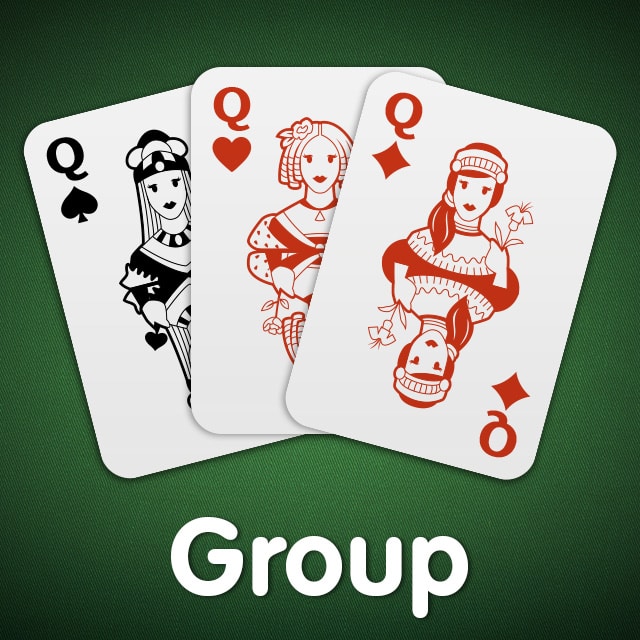
Groups or sets consist of at least three cards of the same rank. But each suit – Clubs, Spades, Hearts, and Diamonds – can only appear once per group. That limits them to four cards at most.
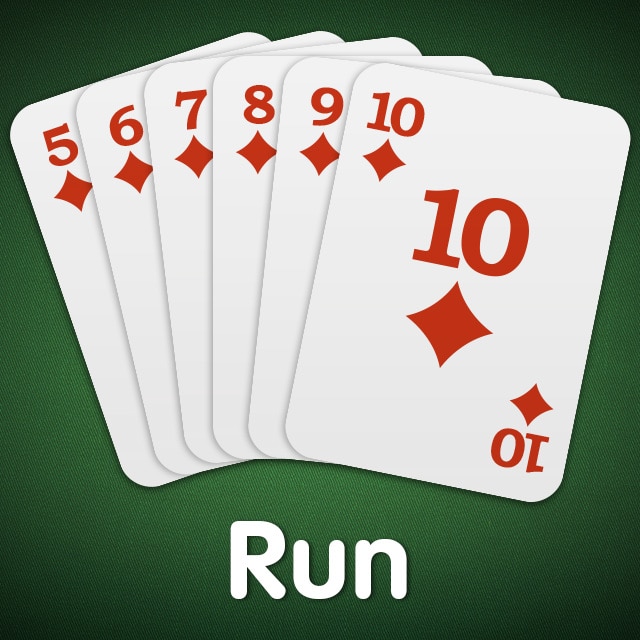
Runs or sequences consist of three to 13 subsequent cards of the same suit. Each rank can only appear once per sequence. The following order applies: (Ace), Two, Three, Four, Five, Six, Seven, Eight, Nine, Ten, Jack, Queen, King, (Ace). The Ace can either open or conclude a run, but it cannot sit between two cards!
Check out our lesson on melds in Rummy to learn more about melding your cards.
The Initial Meld
The first meld you will play in any round of Rummy must score at least 30 points in total. You can achieve this score by playing several melds in the same turn. Apart from that, the usual rules for melds apply (see above). Mind the varying Ace score in runs here – one point before the Two, 11 points after the King.
After playing the first meld, you are free to play any number of moves during your turns in this round.
Adding Cards
In case you have hand cards that would complete melds in the playing field, you can append them at any time in your turn. And it does not matter who played the meld originally. Rules for melds still apply: A group can have only one card of each suit, and runs consist of 13 cards at most, with the Ace either at the end or the beginning.
Swapping Jokers
Some melds in the playing field might contain Jokers. If the fitting card is in your hand, you can insert your handcard in your turn and add the Joker to your hand. You are free to use it in the same turn, later, or discard it as your last card.
End of the Game
When you are the first one to place your Rummy cards in melds and discard the last one on the discard pile, you exclaim: “Rummy!” The round has ended, and you won! Now, the other players receive minus points for their respective remaining hand cards. In turn, you gain the sum of all minus points as positive points.
If the stock is used up before a player could empty their hand, the round ends without a winner and all players lose points.
At a table at the Rummy Palace, you can play several rounds and consecutively collect points. A table ends after a predefined number of rounds was played. Finally, the player with the highest total score wins!
A Particular Case: Going Rummy
Sometimes you are lucky and receive perfectly matching cards. Seize the chance while no other player has any melds: When you end the round by playing all your cards within one turn, you are going Rummy. That doubles the opponents’ penalty points as well as your gained points!
Read our lesson about Going Rummy to learn more about this topic.
Scoring Points in Rummy
Now you know how to play Rummy. But how do you score? At the end of a round, each player loses points equal to the summed-up values of their remaining hand cards. And the winner gains the sum of all their fellow players’ scores.
Remaining hand cards score as follows:
| Rank | Value in Points |
|---|---|
| Two to Nine | According to rank (2, 3, 4, 5, 6, 7, 8, 9). |
| Ten, Jack, Queen, King | 10 |
| Ace | 11 |
| Joker | 20 |
In the case of going Rummy, all positive and negative scores count double! And when you are playing several rounds, the player with the highest total score after the last round wins the table.
Find out more about how scoring works on our page on scoring in Rummy.
Custom Rummy Rules: Mix it Up!
At the standard tables in the lobby, the rules of Rummy described above apply. Mix and match custom rules to create the version you and your friends like best. You can choose from the following options:
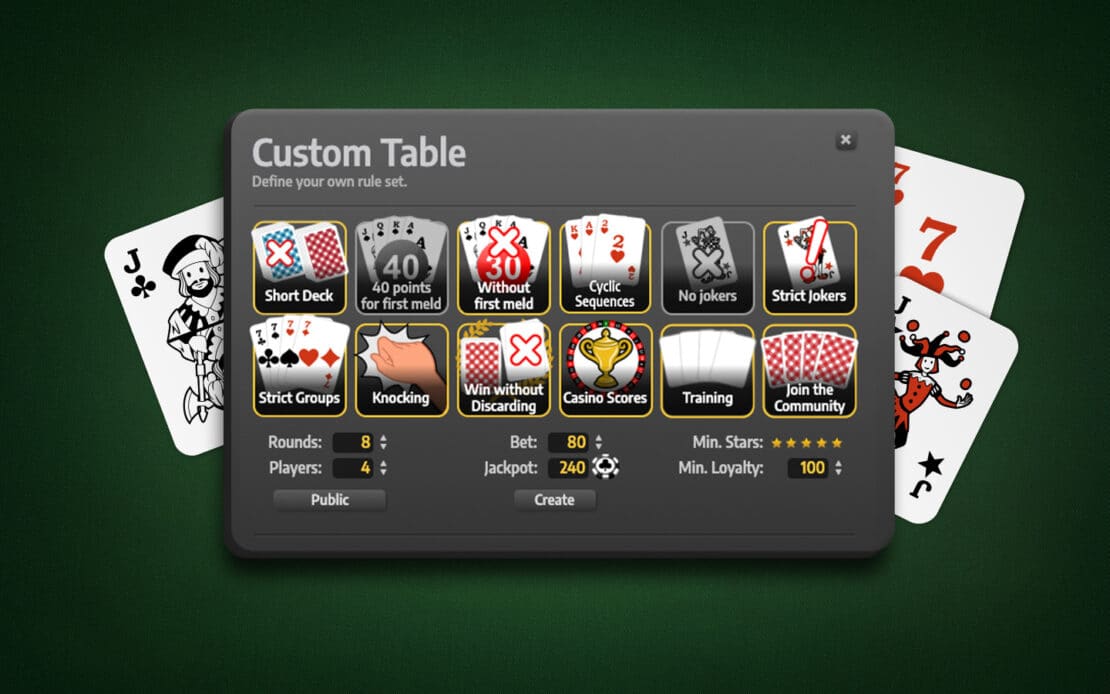
| Custom Rule | Description |
|---|---|
| Short Deck | Only one deck of French-suited playing cards is used, i.e., 55 cards – three of them Jokers. Additionally, in a two-player game, players receive ten hand cards each, or seven each with more players. And the custom rule Without First Meld is automatically enabled. |
| 40 Points for First Meld | The score requirement for your initial meld of each round is raised from 30 to 40 points. |
| Without First Meld | There is no score requirement for the first meld of each round at this table. |
| Cyclic Sequences | With this custom rule, the Ace can also sit between other cards in sequences instead of at the beginning or end only. Sequences must still consist of 13 cards at most. |
| No Jokers | All Jokers are removed from the deck. As a result, 104 instead of 110 Rummy cards are in the game. |
| Strict Jokers | Using this custom rule, you can neither discard Jokers, nor have two consecutive Jokers in a meld. Before swapping a Joker in a group with your hand card, the group must be complete, i.e., contain four cards. Swapped Jokers must be played within the same turn. |
| Strict Groups | This rule specifies the order of suits in groups: Clubs, Spades, Hearts, Diamonds must always be followed without interruption. That requires special attention with Jokers: Clubs – Joker – Hearts would work since only Spades is missing, which is replaced by the Joker. Joker – Clubs – Spades would not work since Clubs is the first suit of the order. Hence, the Joker cannot replace any card before it. |
| Knocking | Now, you can gain the last discarded card even outside of your turn by knocking. If you knock and receive a card, you must draw an additional card from the stock. Whoever knocks or draws first, gets the card. The next player in regular order does not have to knock but can draw from the stock or discard pile. You cannot knock for a card you just discarded. Hence, this rule only works with three and more players. |
| Win Without Discarding | You do not have to discard the last hand card anymore to finish the round. Instead, you can meld it or add it to a meld in the playing field. |
| Casino Scores | The scoring at the end of a round is modified. We explain the differences to our standard scoring on our Rummy scoring page. |
| Training | With this custom rule, the results of the table do not count for the league. You are still gaining experience points, though. |
Head over to our lesson on the different Rummy variations and custom rules to read about this in more detail.
Now that you know how to play Rummy, you might want to delve deeper into the Rummy rules and gameplay. To do so, you can find more explanations and tips on Rummy strategy beyond this Rummy manual in our Rummy Lessons.
Play as Much as You Like!
At the Palace of Cards, you can find many popular card games online alongside Rummy. Shed your hand cards Canasta or Mau Mau. Or try one of our trick-taking games – Pinochle, Sheepshead, Skat, and Doppelkopf. Or are you feeling more like solitaire games? We can offer you Klondike and Spider.

